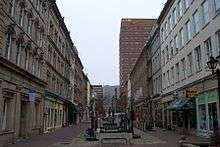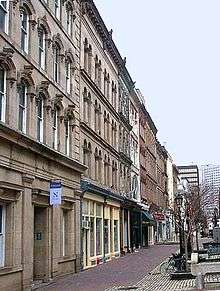NSCAD University
Coordinates: 44°38′58.02″N 63°34′26.23″W / 44.6494500°N 63.5739528°W
 | |
| Motto | Head, Heart, and Hand |
|---|---|
| Type | Public |
| Established | 1887 Victoria School of Art and Design (1887-1925). Subsequent names, Nova Scotia College of Art (1925-1969), Nova Scotia College of Art and Design (1969-2003), and now, NSCAD University. |
| President | Dianne Taylor-Gearing |
Academic staff | 85 (regular staff) |
| Students | 830[1] |
| Undergraduates | 800 |
| Postgraduates | 30 |
| Location | Halifax, Nova Scotia, Canada |
| Campus | Urban |
| Colours | Purple and Green |
| Affiliations | UACC, CBIE, AICAD |
| Website | http://nscad.ca/ |
NSCAD University, also known as the Nova Scotia College of Art and Design, is a post-secondary art school located in Halifax, Nova Scotia, Canada.
During the 1970s NSCAD was hailed as a cutting edge art school, which emphasized artistic innovation, and political art. Currently the university is forging relationships with galleries, museums and other cultural institutions in Canada and around the world.
Academics
NSCAD offers bachelor's degrees in Fine Art (BFA), Design (BDes), and Art History (BA). It also offers Master of Fine Arts and Master of Design degrees at the graduate level.
Faculties
- Craft
- Design
- Fine Arts
- Foundation
- Historical and Critical Studies
- Media Arts
- NSCAD University Press
- Libraries
Libraries and Museums
Historical fine arts and ceramics; contemporary fine arts and printmaking collections are housed in the Anna Leonowens Gallery.[2] The Gallery hosts exhibitions of the work of undergraduate and graduate students, faculty members, visiting artists and curators. [3]
History




NSCAD was founded in 1887[4]:2,12 by Anna Leonowens (of Anna and the King of Siam fame).[4]:3[lower-alpha 1] It was originally called the Victoria School of Art and Design to commemorate Queen Victoria's Golden Jubilee. It was renamed to the Nova Scotia College of Art in 1925[4]:94–95[lower-alpha 2] under the leadership of its president Dr. Frederick Sexton.[4]:104[lower-alpha 3]
One of the notable artists to be associated with the school in its early years was Arthur Lismer, who was a member of the Group of Seven and spent several years as the school president.[4]:69–78
NSCAD and conceptual art
In 1967, the artist Garry Kennedy was appointed President, and he immediately moved to remake the College from a provincial art school into an international centre for artistic activity. He invited notable artists to come to NSCAD as visiting artists, particularly those involved in conceptual art. Artists who made significant contributions during this period include Vito Acconci, Sol LeWitt, Dan Graham, Eric Fischl, Lawrence Weiner, Joseph Beuys and Claes Oldenburg.
NSCAD University Press
Under the direction of Kennedy, The Press of the Nova Scotia College of Art and Design was established as a vehicle to publish books by and about leading contemporary artists. The Press was important in establishing the university's international reputation. Between 1972 and 1987, 26 titles by such artists as Michael Snow, Steve Reich, Gerhard Richter and Yvonne Rainer were published. Re-launched in 2002, The Press has once again become a source for the publishing of primary documents and scholarly works in the fields of contemporary art, craft and design.
Timeline
NSCAD has existed under various names and locations.
- 1887 the Victoria School of Art and Design opens in the Union Building
- 1890 the school moves to Halifax Academy
- 1903 the school moves to the old National School[4]:50
- 1925 the school is renamed the Nova Scotia College of Art[4]:94–95
- 1957 the school moves to a four storey church hall on Coburg Road[4]:141
- 1969 the school is renamed the Nova Scotia College of Art and Design[4]:147
- 1969 the school begins granting undergraduate degrees[4]:147
- 1973 the school begins offering graduate programs[4]:161
- 1978 NSCAD moves to its current location in the Historic Properties buildings on Granville Street[4]:160–161
- 2003 the school is renamed NSCAD University
- 2004 NSCAD expands into its second campus – the Academy Building for film studies
- 2007 NSCAD expands into its third campus, the Port Campus, on the Halifax Waterfront at Pier 21
School of Extended Studies
NSCAD has a long and distinguished history of offering the public the opportunity to study in a visual arts environment. The School of Extended Studies continues this tradition by offering the public a wide variety of non-credit studio and audit lecture courses in fine arts, media arts, craft and design. The School also manages the 30-credit Visual Arts Certificate for Teachers program, the 30-credit Visual Arts Certificate in Studio and the pre-university summer study credit program. Credit programs have admission requirements. Noncredit programs have no admission requirements although prerequisites must be met for some courses.
Adult Programs The adult studio-based and audit lecture courses are available to individuals who are 16 years or older. These courses are designed to meet personal and professional development interests and to prepare for studies in an undergraduate visual arts degree program. Curricula incorporate skills, processes, and health and safety issues. New approaches and ways of seeing, analyzing, experimenting and problem solving through observation are promoted. To ensure program quality, planning is ongoing with other areas of NSCAD University. New courses are added regularly to introduce different subject matter and in response to public demand.
Children and Teen Programs Saturday Children’s Art Classes began in 1887 and are one of the earliest known examples of such programs in North America. Children in grades 1 – 6 participate in a variety of fun age-appropriate activities that introduce basic visual arts skills.
Teen Art Studio courses for students in Grades 7 -12 introduce fundamental visual art skills and processes, introduce NSCAD facilities and provide older teens an opportunity to build a portfolio for admission to an undergraduate visual arts degree program. Saturday teen courses are offered during the fall and winter and week-long courses are offered during summer. One-day March Break workshops are offered during the Provincial school break.
Night Shift Exhibit An annual Night Shift Exhibition to display student work completed in Extended Studies course is held in the Anna Leonowens Gallery located on the NSCAD Granville campus. Family and friends are encouraged to attend this popular exhibit and enjoy a variety of different works of art created by all ages.
Notable people
- Vikky Alexander - artist
- Thomas Bezanson - pottery
- Jennifer Bolande- artist
- Heather Cassils - performance artist
- Cliff Eyland - artist
- Gerald Ferguson - faculty
- Michael Fernandes - artist
- Parris & Chloé Gordon - co-owners of Chloé comme Parris
- April Gornik - painter
- Hedwig Gorski - performance poet and artist
- Lonnie Graham - photographer
- Jenn Grant - singer/songwriter
- Steven Holmes - curator
- Teresa Hubbard and Alexander Birchler - artists
- John Kahrs - Academy Award-winning director of Paperman
- Laura Kipnis - media critic
- Micah Lexier - artist
- Toshiko MacAdam - textile artist
- Bruce MacKinnon - editorial cartoonist for the The Chronicle Herald
- Kerri MacLellan - musician
- Christopher Manson - children's book author/illustrator
- Kelly Mark - sculptor, conceptualist
- Sarah McLachlan - singer/songwriter
- Lisa Moore - writer
- Chris Murphy - musician
- Jimmy Rankin - singer/songwriter
- Julia Rivard - athlete, designer
- William James Roué - designed the Bluenose schooner
- Andrew Scott - musician
- Peter Soucy - comedian
- Tiffany Shaw-Collinge - artist and architect
- Tanya Tagaq - singer/songwriter
- Monica Tap - artist, educator
- Heather Young - filmmaker
University history
- Kennedy, Garry Neill. The Last Art College: Nova Scotia College of Art and Design, 1968-1978 (Cambridge: The MIT Press, 2012.) ISBN 978-0-262-01690-2
- Wark, Jayne. "Conceptual Art in Canada: The East Coast Story" Traffic: Conceptual Art in Canada 1965-1980 (Canada: Art Gallery of Alberta, Halifax INK, Justina M. Barnicke Gallery of University of Toronto, Leonard & Bina Ellen Art Gallery of Concordia University, and The Vancouver Art Gallery) pp 16–37 ISBN 978-1-895442-88-5
- Barber, Bruce. Conceptual Art: the NSCAD connection 1967-1973 (Halifax: Anna Leonowens Gallery, 1998.) ISBN 0-920149-14-6
- Soucy, Donald and Harold Pearse. The First Hundred Years: A History of the Nova Scotia College of Art and Design (Fredericton: University of New Brunswick, 1993.) ISBN 0-920114-27-X
- Stacey, R. H.(Robert H.). Eightytwenty: 100 years of the Nova Scotia College of Art and Design (Halifax : Art Gallery of Nova Scotia, 1988.) ISBN 0-88871-106-9
- Kennedy, Garry N., Kenneth Baker, Eric Cameron, Benjamin H.D. Buchloh. NSCAD, The Nova Scotia College of Art and Design (Halifax: Press of the Nova Scotia College of Art and Design, 1982.) ISBN 0-919616-23-2
See also
References
- ↑ "unican.ca".
- ↑ "Anna Leonowens Gallery, NSCAD University". Virtual Museum of Canada. Government of Canada.
- ↑ "Anna Leonowens Gallery". NSCAD University.
- 1 2 3 4 5 6 7 8 9 10 11 12 Soucy, Donald; Pearse, Harold (1993). The First Hundred Years: A History of the Nova Scotia College of Art and Design. Fredericton: University of New Brunswick. ISBN 0-920114-27-X.
Notes
- ↑ Soucy & Pearce (1993) give four “initiators” in ch. 1: Anna Leonowens, a Mrs. Jeremiah Kenny (first name not known), Ella Almon Ritchie, and Alexander McKay. However, speaking of Anna Leonowens, “Most people agree that the Victoria School of Art and Design was her idea.” (p. 3)
- ↑ “In 1925, thirty-seven years after it first received its charter, the Victoria School of Art and Design was no more.… a legislative act elevated the institution’s status to that of a college.” (p. 94) “Along with the new status came a new name, the Nova Scotia College of Art, and a motto, ‘Heart and Head and Hand.’” (p. 95)
- ↑ “When Sexton, as President, oversaw the Art College’s new Legislative Act of 1925,…” (p. 104)
External links
| Wikimedia Commons has media related to Nova Scotia College of Art and Design University. |
